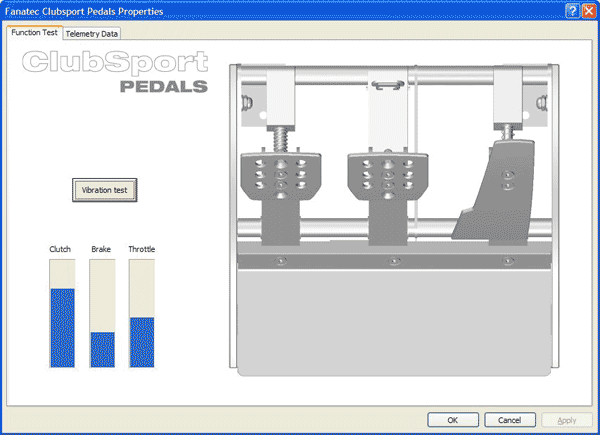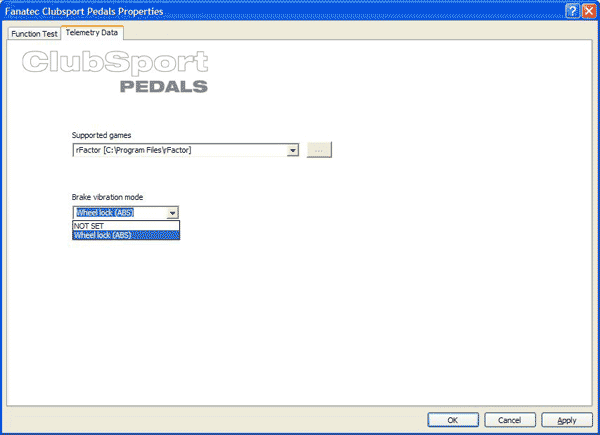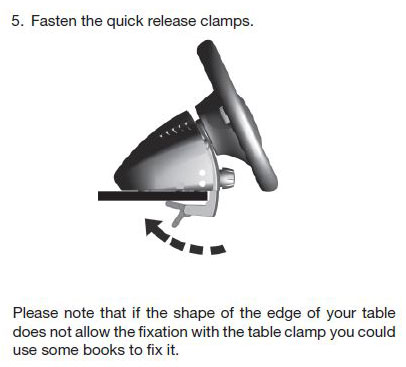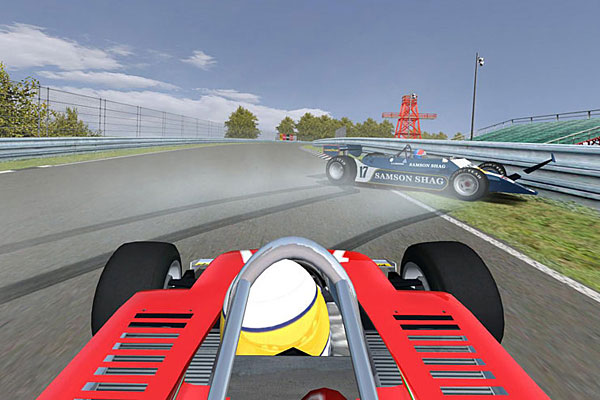|
Review: The Fanatec Porsche GT3 RS Wheel
Back
to Page 1
Pedal Technical Details
The Clubsport Pedals use non-contact hall sensors for the throttle and clutch, and a load cell sensor on the brake pedal. It is possible to move the pedals faces up, down, left and right, as well as change the mounting points for the pedal arms (which changes the pedal face angles and the extents of rotation). There is a knob on the pedal base that controls the force required for maximum braking. While it is not marked for any quantitative settings, the lowest setting is plenty for a racer in a typical desk chair. At a slightly higher setting I need to hold on to my desk with both hands and push to achieve maximum braking force; this has a tendency to rotate the front of the pedal base up off of the floor. At maximum braking force I can literally stand on the pedal and only achieve about 30% of maximum braking force.
It would be nice if the Clubsport brake pedal force worked in a bit smaller range, since the max force setting seems to be well beyond the point at which it would be useful; this would allow for finer adjustments. It would also be nice if the minimum force could be set a little lower than is currently possible, which might accommodate a wider range of users. Having said that, less force is required to squeeze the Clubsport brake pedal to 100% braking at a minimum force setting than is required to push the Logitech G25 pedal to 100% braking.
However, the Clubsport Pedals have no carpet grippers; they rely on their weight and four rubber pads at the four corners of the pedal base. On my carpet they undoubtedly have a tendency to move while racing, much more so than Logitech G25 pedals. If you're going to invest in these pedals, it makes the most sense to install them in a racing cockpit or at least in a setup where the chair and the pedals are on a common base structure.
On paper, one of the best features of the Clubsport Pedals is the vibration feedback in the brake pedal. There is a small motor near the brake pedal that oscillates and shakes the pedal when commanded. With the PWTS, this feature can be linked to engage with a certain amount of brake input. This is not available when Clubsport Pedals are paired with the GT3 RS, but the same rFactor plug-in that controls telemetry-based wheel display information can control the brake vibration feedback motor when the option is enabled in the Fanatec properties page. This means that the brake pedal vibrates when one or more wheels is locked, regardless of how hard the brake pedal is being pressed. Ostensibly this is a great feature, as it can be very hard to tell in sim-land if a wheel has locked up, especially when locking rear wheels and/or when driving closed-wheel vehicles. However, the vibration that is provided isn't strong enough. I can feel it if I'm specifically expecting it, but in the heat of battle during a race the vibration is all but undetectable, even driving in socks. Fanatec tried a bigger motor to help alleviate this problem, but they say that the problem is really the stiffness of the brake pedal itself; it is so solid that even a bigger motor doesn’t help much to increase the shaking.
 |
| |
 |
Wheel Problem #1 - Clamping System
The PWTS and GT3 RS utilize a different clamping system than wheels designed by Logitech and Thrustmaster. Most wheels clamp to a horizontal surface, squeezing that surface between the top and bottom of the wheel mounting system via hand-tightened clamps. The Fanatec wheels have an assembly that slides up and down from the bottom of the wheel base, but when this assembly is tightened it does not firmly clamp the wheel to a desk or table. Instead, it locks the assembly in place, close to the desk or table. After that, the user flips the two "quick release clamps" up, which greatly increases the clamping pressure and supposedly secures the wheel to the mounting surface. However, as you can see in the attached screenshot from the GT3 RS manual, this leaves space between the clamping bracket and the mounting surface. While this space is small, it's enough to permit the wheel housing to rock up and down slightly. Over the course of an extended driving session this rocking can be enough to cause the wheel to come loose, which has happened to me a number of times. I have taken to referring to the "quick release clamps" as "slow release clamps", because they slowly release the wheel as I drive. This tendency is most likely exacerbated by my tendency to compensate for squeezing the load-sensor pedal by slightly pulling my wheel away from my desk under braking. As with the pedals, the wheel can accommodate bolt-mounting, which may be in the user's best interests.
 |
Wheel Problem #2 - Problems with the Force Feedback System?
During a recent SimHQ Motorsports racing event I was using the GT3 RS and the Clubsport Pedals. I was weaving around during the formation lap to heat my tires when, suddenly, every time I turned the wheel quickly to the right the force feedback mechanism would catch and the wheel would make a loud snapping or popping sound.
Here is the sad result of my force feedback problem.
I contacted Fanatec Customer Support and they replied 3 days later, on a Saturday, with a request for a video demonstrating the problem. I created a short video and sent it off. It took an additional 8 days to receive another response from Fanatec, and this time they indicated that the wheel was definitely bad. They are going to cross-ship me a replacement. While the eventual outcome of this tech support exchange was a happy ending (unless the replacement hardware develops similar problems), it took quite a long time for the process to play out. More importantly, high-end hardware like this should not fail when it has been used for only a month.
Conclusion
Like "Chunx" found in his review, I think that the feeling of the Fanatec wheel and pedals is superb. Switching from a gear-driven to a belt-driven force feedback system results in a heavenly feeling of smoothness and control. The Clubsport Pedals, especially the load sensor brake pedal, are wonderful, and the pedal positions can be customized to suit the individual. If "Chunx'" review of the Porsche Turbo S wheel piqued your interest, but you don’t want to spend $250 USD on a cross platform wheel because you don’t drive on your consoles, then the GT3 RS wheel might be for you. And the Clubsport Pedals should be a must-have for any serious sim racer, especially with their recent price drop to $150 USD.
There is only one concern about shelling out the money for all of this high-end hardware: will it last? There are scattered reports on the SimHQ Forums of Fanatec hardware failures. Unfortunately, this review unit did little to dispell the concern. This review sample only worked properly for about 20 hours before it developed the problem explained above.
System Specs
- Intel Core 2 Duo @ 2.53 GHz
- NVIDIA 8800 GTS 640MB
- 4GB DDR2 RAM
- Windows XP SP3
We want your Feedback.
Please let us know what you thought of this article here.
Click here
to go to top of this page.
|




